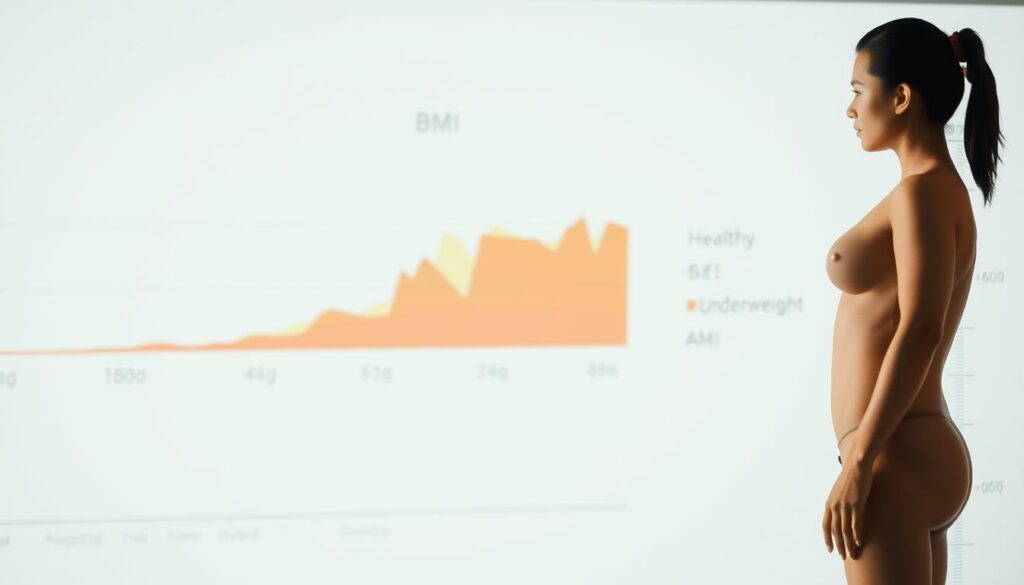Why do so many women feel their body behaves differently after midlife? For years, we’ve heard whispers about hormonal shifts reshaping metabolism. But what’s fact, and what’s fiction? Today, we’re unpacking the relationship between natural aging processes and health metrics like BMI.
Dr. Nathan Ratchford, a leading endocrinologist, clarifies that menstrual cycles naturally end between ages 45 and 55 for most. This transition often overlaps with lifestyle changes, muscle loss, and stress patterns. While some blame hormones alone for midlife shifts, research shows diet quality and activity levels play equally critical roles.
BMI—a ratio comparing height to mass—remains a common tool for assessing wellness. But does it account for hormonal water retention or muscle-fat redistribution? We’ll explore how medical experts interpret these numbers during life stages marked by biological transitions.
Together, we’ll separate myths from evidence-based strategies. Later sections dive into practical steps for maintaining vitality, but first: let’s examine the science behind the scale.
Key Takeaways
- Midlife metabolic changes involve hormones, lifestyle, and aging
- BMI calculations may not fully reflect body composition shifts
- Weight management requires personalized approaches
- Muscle preservation becomes crucial post-45
- Expert insights help navigate health metrics effectively
Understanding Menopause and Its Impact on Weight
Midlife brings transformative shifts in women’s health that often go beyond common expectations. One pivotal change—the natural end of menstrual cycles—typically occurs between ages 45 and 55. This biological milestone signals the conclusion of childbearing years and introduces new metabolic patterns.
What Is Menopause and When Does It Occur?
Medical professionals define this transition as occurring 12 months after a woman’s final period. While timing varies, most experience it in their early 50s. Hormonal fluctuations during this phase—particularly a decrease in estrogen—trigger various physical responses.
Common Symptoms and Body Changes
Three out of four women report disruptive symptoms like:
| Symptom | Frequency | Impact Level |
|---|---|---|
| Hot flashes | 75% | Moderate |
| Night sweats | 68% | High |
| Mood swings | 60% | Variable |
These changes often coincide with shifts in body mass distribution. While some weight gain is common, it stems from multiple causes—not just hormones. Reduced physical activity, muscle loss, and stress responses all play roles.
Understanding these patterns helps explain why traditional BMI measurements might not fully capture health status during this phase. Later sections will explore personalized strategies for navigating these changes effectively.
Does Menopause Affect Ideal Weight Calculations?
How reliable are standard measurement tools when evaluating physical changes in midlife? While body mass index remains a common health indicator, its simplicity often masks critical details. A 2023 Johns Hopkins study revealed BMI classifications misrepresent body composition in 39% of women over 45.
Role of Body Mass Index in Evaluating Weight
BMI calculates weight relative to height but ignores fat-muscle ratios. This becomes problematic when hormonal shifts alter where and how bodies store energy. “A woman might maintain the same BMI for years while replacing muscle with fat,” explains Dr. Ellen Torres, a metabolic health specialist.
Comparing Pre- and Post-Menopausal Weight Metrics
Midlife changes often involve:
| Body Composition | Pre-Transition | Post-Transition | Implications |
|---|---|---|---|
| Fat Distribution | Hips/Thighs | Abdomen | Higher metabolic risks |
| Muscle Mass | Stable | 3-8% decline | Slower metabolism |
| Water Retention | Cyclical | Persistent | Scale inaccuracies |
These shifts explain why weight gain alone paints an incomplete picture. Muscle loss reduces calorie needs, while visceral fat increases health risks—factors BMI overlooks. Tracking waist circumference and strength metrics often provides clearer insights.
Understanding mass index variations helps create personalized health strategies. Rather than fixating on numbers, focus on sustainable habits that preserve muscle and manage fat distribution through life’s transitions.
Hormonal Shifts, Metabolism, and Body Composition
What reshapes our bodies during midlife transitions? The answer lies in complex interactions between hormones and cellular processes. Declining estrogen levels act like a conductor, orchestrating where fat settles and how efficiently we burn energy.
Estrogen’s Role in Fat Storage Patterns
This key hormone influences fat distribution by directing storage toward hips and thighs during reproductive years. As levels drop, fat increasingly accumulates around the abdomen. Visceral fat—the dangerous type surrounding organs—becomes more common, raising health risks even if scales show minimal change.
A 2023 analysis found women lose 3% muscle mass annually during this phase without intervention. Muscle tissue burns calories three times faster than fat, so this decline slows resting metabolism by 5-8%.
Metabolic Slowdown and Muscle Dynamics
Three factors drive metabolic shifts:
- Reduced estrogen weakens muscle protein synthesis
- Insulin sensitivity decreases by 25-30%
- Mitochondrial energy production drops
These changes create a perfect storm for body composition shifts. Prioritizing strength training becomes crucial—it counters muscle loss and boosts metabolic rate more effectively than diet alone. Understanding these biological realities helps craft strategies that work with our bodies rather than against them.
Managing Health Risks During the Menopausal Transition
Midlife hormonal changes bring hidden challenges beyond physical symptoms. Shifting body composition patterns can quietly elevate risks for serious conditions. Awareness becomes the first line of defense against preventable health issues.
Identifying Risks: Heart Disease, Diabetes, and More
Studies show women face a 50% higher heart disease risk after midlife transitions. Excess abdominal fat produces inflammatory markers that strain blood vessels. This inflammation doubles the likelihood of developing type 2 diabetes compared to pre-transition years.
Three critical connections demand attention:
- Visceral fat releases hormones affecting insulin sensitivity
- Blood pressure spikes correlate with waist size increases
- Chronic inflammation accelerates artery plaque formation
Understanding Visceral Fat and Its Implications
Not all fat behaves the same. Belly fat surrounding organs actively disrupts metabolic functions. Just 2 inches added to waist circumference raises diabetes risk by 30% according to recent data.
| Fat Type | Location | Health Impact |
|---|---|---|
| Visceral | Around organs | High disease risk |
| Subcutaneous | Under skin | Lower risk profile |
Tracking body weight alone misses these critical distinctions. Combining waist measurements with BMI provides clearer risk assessments. Early interventions focusing on nutrition and stress management can significantly improve quality life outcomes during this transition phase.
Adjusting Diet and Exercise for a Healthy Transition
Navigating midlife transitions requires smart strategies that adapt to biological changes. While metabolism naturally slows, combining targeted nutrition with purposeful movement creates sustainable results. Let’s explore actionable steps to support your body through this phase.
Fueling Your Body Wisely
Shift focus from restriction to nourishment. The Mediterranean diet—rich in fish, nuts, and olive oil—reduces inflammation linked to hormonal shifts. Prioritize these foods:
| Food Group | Benefits | Examples |
|---|---|---|
| Lean Proteins | Preserves muscle mass | Salmon, lentils |
| Fiber-Rich Carbs | Stabilizes blood sugar | Quinoa, berries |
| Healthy Fats | Supports hormone production | Avocados, chia seeds |
Movement That Matters
Blend cardio with resistance training. Studies show women who lift weights twice weekly maintain 40% more muscle than sedentary peers. Effective routines include:
- 30-minute brisk walks (5 days/week)
- Bodyweight exercises (squats, planks)
- Yoga for flexibility and stress relief
Calorie Quality Over Quantity
Metabolic rates drop by 100-200 calories daily post-45. Instead of drastic cuts, focus on nutrient-dense meals. Swap sugary snacks for Greek yogurt with almonds—same calories, better fuel. Use our healthy weight calculator to personalize intake based on activity levels.
Remember: Sustainable weight loss stems from consistency, not extremes. Pair smart eating with regular exercise to protect muscle and manage body composition effectively.
Conclusion
Midlife transitions reshape more than calendars—they redefine how our body interacts with energy and aging. Through hormonal shifts and metabolic changes, women often experience fat redistribution toward the abdomen, altering health risk profiles. While some weight gain proves common, focusing solely on scales misses critical details about muscle retention and visceral fat accumulation.
Monitoring BMI remains useful but incomplete. Pair it with waist measurements and strength assessments for a complete picture. Research confirms that preserving muscle mass through resistance training counteracts 65% of age-related metabolic slowdown.
Practical strategies make lasting impacts. Adjust dietary priorities toward protein-rich foods and heart-healthy fats. Combine this with regular exercise that challenges muscles while supporting joint health. These steps help manage blood sugar levels and reduce cardiovascular risks linked to abdominal fat.
Every woman’s journey differs, but proactive choices create resilient outcomes. Revisit earlier sections for meal plans, workout routines, and expert insights tailored to this life phase. With informed action, midlife becomes an opportunity to refine—not redefine—your relationship with wellness.



